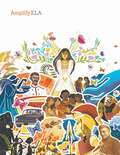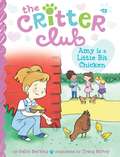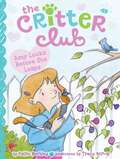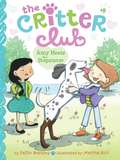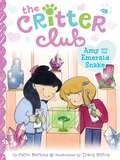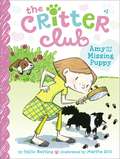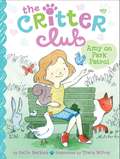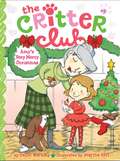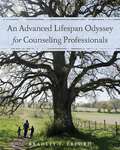- Table View
- List View
Amplify Science: California Student Edition, Grade 7, Integrated
by Amplify EducationNIMAC-sourced textbook
Amsco's Science, Grade 7
by Paul S. Cohen Anthony V. SorrentinoProvides a clear and concise presentation of middle school science concepts.
Amy Is a Little Bit Chicken: Liz And The Sand Castle Contest; Marion Takes Charge; Amy Is A Little Bit Chicken; Ellie The Flower Girl; Liz's Night At The Museum; Marion And The Secret Letter; Amy On Park Patrol; Ellie Steps Up To The Plate; Liz And The Nosy Neighbor; Etc (The Critter Club #13)
by Callie BarkleyAmy and her friends care for some chickens and prepare for the Santa Vista Quiz Bowl in the thirteenth book of The Critter Club series!Amy has never liked being in the spotlight. When all of her friends decide to form a team for the Santa Vista Quiz Bowl, Amy isn’t so sure it’s a good idea. She knows she can answer the quiz questions…but can she do it in front of hundreds of people? Meanwhile, the Critter Club is caring for a few chickens that need a home. And as the day of the Quiz Bowl gets closer, Amy starts to feel a little bit chicken herself! Will she get over her stage fright and help her team win? With easy-to-read language and illustrations on almost every page, The Critter Club chapter books are perfect for beginning readers!
Amy Looks Before She Leaps (The Critter Club #29)
by Callie BarkleyIn the twenty-ninth book of the Critter Club series, Amy meets a blind stray cat!When Amy finds a stray cat who&’s blind, she throws all her time and effort into caring for her. She even wants to skip sleepovers with the Critter Club! But eventually, Amy discovers that the cat can do lots of things on her own, too. It&’s time for the Critter Club to help the cat find a new, loving forever home. With easy-to-read language and illustrations on almost every page, The Critter Club chapter books are perfect for beginning readers.
Amy Meets Her Stepsister: Amy Meets Her Stepsister; Ellie's Lovely Idea; Liz At Marigold Lake; Marion Strikes A Pose (The Critter Club #5)
by Marsha Riti Callie BarkleyAmy is excited to meet her new stepsister Chloe. . . but it turns out Chloe doesn't feel the same way Can Amy and Chloe get along? Amy's mom and dad have been divorced for as long as Amy can remember, but nothing prepares Amy for the news she gets on a weekend visit to her dad's house in Orange Blossom: Amy's dad is remarrying In addition to getting a stepmother, Amy will also be getting a stepsister her age named Chloe. As the girls spend more time together, Amy realizes that Chloe isn't as nice as she appears to be in front of the grown-ups. Chloe plays pranks on Amy and is just downright mean to her. Amy worries that she'll be stuck with this stinky stepsister for life. Will she and Chloe ever be friends? With easy-to-read language and illustrations on almost every page, The Critter Club chapter books are perfect for beginning readers.
Amy and the Emerald Snake (The Critter Club #25)
by Callie BarkleyIn the twenty-fifth book of the Critter Club series, Amy wonders whether her best friends like her stepsister more than they like her. Plus, they all care for a charming snake at the club!Amy&’s stepsister, Chloe, is coming to town! Amy can&’t wait to take her to the big gemstone exhibit at the museum, but she&’s even more excited to introduce Chloe to her friends. And when she does, the girls all love Chloe. At first Amy is happy, but then she starts to wonder if her friends like Chlore more than they like her! Even the snake they&’re taking care of at the club seems friendlier to Chloe! Has the Critter Club found a new member—or even a replacement? With easy-to-read language and illustrations on almost every page, The Critter Club chapter books are perfect for beginning readers.
Amy and the Missing Puppy: Amy And The Missing Puppy; All About Ellie; Liz Learns A Lesson (The Critter Club #1)
by Marsha Riti Callie BarkleyIntroducing The Critter Club! Amy and her friends solve a canine caper in this start to a pet-friendly illustrated chapter book series.It's Spring Break in Santa Vista, and everyone has big plans...everyone except for Amy, that is! As her best friends head out of town on exciting adventures, Amy resigns herself to helping out at her mom's vet clinic. At least she'll be around cute animals! But when Santa Vista's cold and elusive millionaire, Marge Sullivan, brings her puppy Rufus for a check-up, Amy encounters an unexpected mystery. After her friends return home, the girls get to the bottom of what happened to Rufus--and discover a way to help other lost and lonely animals in their town. With easy-to-read language and illustrations on almost every page, The Critter Club chapter books are perfect for beginning readers.
Amy on Park Patrol: Liz And The Sand Castle Contest; Marion Takes Charge; Amy Is A Little Bit Chicken; Ellie The Flower Girl; Liz's Night At The Museum; Marion And The Secret Letter; Amy On Park Patrol; Ellie Steps Up To The Plate; Liz And The Nosy Neighbor; Etc (The Critter Club #17)
by Callie BarkleyAmy must come up with a plan to save a park—and all the animals living there—in the seventeenth book of the Critter Club series.When Amy learns that part of a nearby park may be destroyed and replaced by a shopping center, she’s devastated. Amy has spent her whole life visiting and playing in that park, and she’s always loved going on nature walks there. She can’t stand the idea that the park—and all the animals in it—would disappear! Can Amy come up with a plan to save the park? With easy-to-read language and illustrations on almost every page, The Critter Club chapter books are perfect for beginning readers!
Amy the Puppy Whisperer (The Critter Club #21)
by Callie BarkleyIn the twenty-first book of the Critter Club series, Amy discovers she has a real knack for training puppies. But when she takes on too many puppy clients, things get out of hand—or paw!When Amy meets the owner of a brand-new puppy at her mom&’s vet clinic, she agrees to help the woman train her new pet. Amy does such a great job, she starts getting calls from more puppy owners! Things go great for a while, but soon, Amy is in way over her head. She can&’t say no to a puppy in need and has taken on way too many clients! Amy barely has time for school or her friends in between all the puppies. Can she dig herself out of this hole before she goes barking mad? With easy-to-read language and illustrations on almost every page, The Critter Club chapter books are perfect for emerging readers.
Amy's Very Merry Christmas (The Critter Club #9)
by Callie BarkleyAmy comes up with the perfect Christmas present for Ms. Sullivan in the ninth book of the Critter Club series.It’s holiday time in Santa Vista, and Amy is especially excited for Christmas. Her dad and soon-to-be stepmom and stepsister are visiting, plus, there are some adorable guinea pigs at the Critter Club. But amidst the hustle and bustle of Christmas preparations, Amy notices that Ms. Sullivan seems a little lonely. Though Ms. Sullivan assures Amy that she will have a lovely holiday with her dog Rufus, Amy begins to wonder if there’s something she can do to cheer up Ms. Sullivan. As Christmas Eve nears, the Critter Club girls still have not found families to adopt the guinea pigs. But then, in a Christmas miracle, each guinea pig gets a home. And come Christmas Day, Amy has devised a great plan to give Ms. Sullivan some cheer—and some company—on Christmas! With easy-to-read language and illustrations on almost every page, The Critter Club chapter books are perfect for beginning readers!
An Act of Courage: The Story of Viola Desmond (Fountas & Pinnell Classroom, Guided Reading)
by Carlo Molinari Marie SpencerNIMAC-sourced textbook. A Night at the Movies. Viola Desmond was looking forward to a quiet night at the movies. But her evening didn't turn out as planned. Instead, Viola took a stand that helped change the course of history.
An Advanced Lifespan Odyssey For Counseling Professionals
by Bradley ErfordWelcome to the lifespan odyssey! This text was designed to align with CACREP standards for counselor training programs. The background education and experiences of counselors in training are quite diverse: many have undergraduate degrees in psychology, education, or human services, while others have undergraduate degrees in business, the humanities, or some other discipline. Thus, some start with a basic understanding of human development and perhaps an undergraduate course on the topic, while others have no previous exposure to the content domain. The alignment with CACREP standards helps all counselors-in-training to master the core knowledge of lifespan development, but more importantly to apply this knowledge to helping people resolve difficulties they may encounter on their lifespan odysseys. These issues might include the implications of substance abuse for development, behavioral or emotional issues associated with trauma or an unstable environment, interventions that have been shown to be effective when working with clients along the spectrum of developmental problems, and the normal and abnormal human developmental processes that counselors must master and apply during clinical experiences--and when they take their rightful place as counseling professionals!

